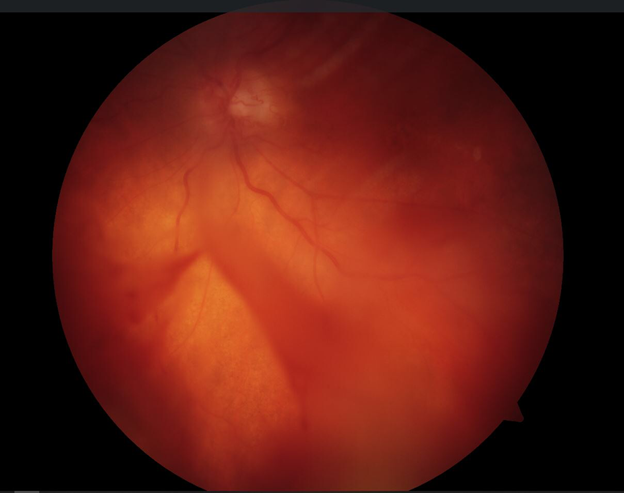Background: A vitreous hemorrhage is a common conditions with a variety of causes. It occurs when a bleed happens within the vitreous, anterior to the posterior vitreous face. Symptoms tend to vary according to severity of the bleed. A mild hemorrhage will result in sudden onset of floaters and diffuse blurring of vision, but it may or may not affect visual acuity. A dense hemorrhage, on the other hand, may result in severely impaired visual acuity. (1)
Causes: The following are causes of a vitreous hemorrhage: acute posterior vitreous detachment associated with either a retinal tear or a separation of a peripheral vessel, proliferative diabetic retinopathy, retinal vein occlusion, sickle cell disease, Eales disease, hypertension, vasculitis, macroaneurisms, telangectasia, capillary hemorrhage, trauma, bleeding disorders, sickle cell retinopathy, retinopathy of prematurity, ocular ischemic syndrome, or Terson syndrome. (1)
 Symptoms: a vitreous hemorrhage will cause a sudden, painless, decrease in visual acuity. Black spots described as “multiple gnats” may also be present with accompanying flashes of light. (1)
Symptoms: a vitreous hemorrhage will cause a sudden, painless, decrease in visual acuity. Black spots described as “multiple gnats” may also be present with accompanying flashes of light. (1)
Evaluation: Mild vitreous hemorrhages may allow for complete or partial visualization of the fundus. Severe bleeds will obstruct partial or complete visualization of the fundus, of which requiring a B scan. B-scan ultrasonography can be used to evaluate a vitreous hemorrhage, as this scan is crucial for the evaluation of eyes with dense bleeds to exclude an underlying retinal tear or detachment. Unclouded vitreous tends to have a uniform appearance, and small particulate echoes become visible once cellular aggregates develop. Chronic vitreous hemorrhages will have a yellow or gray-white appearance. (1)
Treatment: Treatment is determined based upon severity in addition to cause. To note, an increasingly low threshold is being utilized for an early vitrectomy in the cases for a dense bleed. (1)
Reference:
- Bowling, B., & Kanski, J. J. (2016). Kanski’s Clinical Ophthalmology : a Systematic Approach (8th ed.). Edinburgh: Elsevier.

